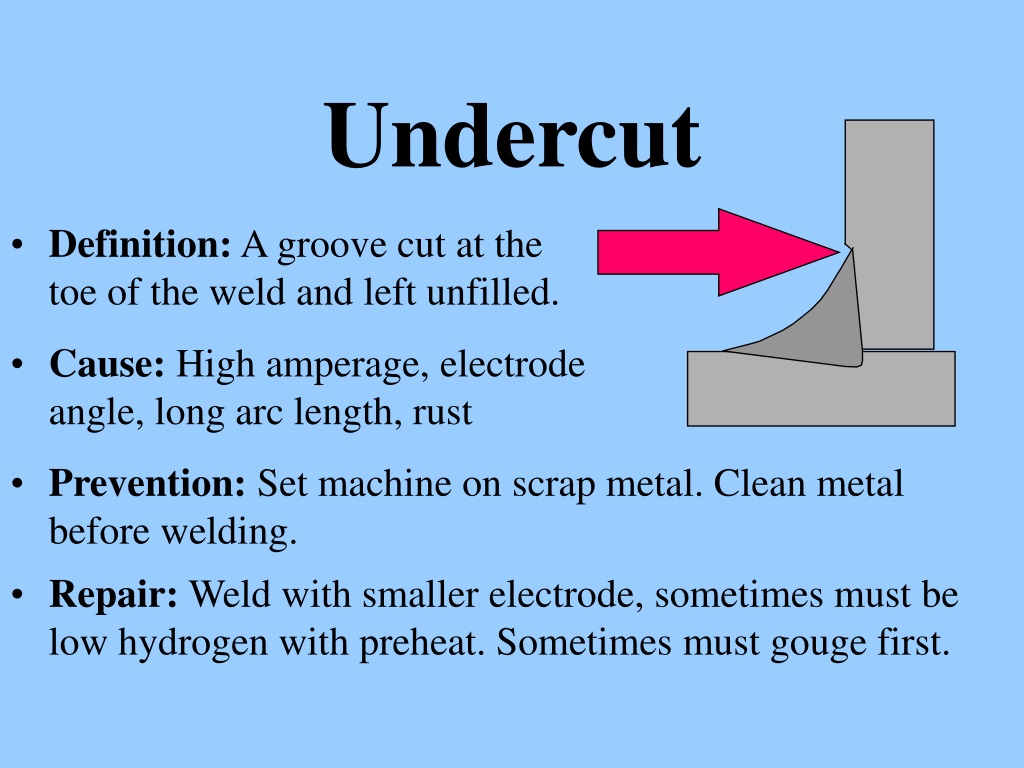Preventing Weld Undercut Demystified: Techniques for Success
Preventing Weld Undercut Demystified: Techniques for Success
Blog Article
Understanding the Art of Welding: Exactly How to Stay Clear Of Undercut Welding Issues for Flawless Manufacture Results
Performance and accuracy are paramount in the world of welding, where even the tiniest blemish can endanger the structural integrity of a produced piece. One typical challenge that welders face is damaging, a problem that can compromise a weld joint and lead to pricey rework. By recognizing the root creates of undercut welding and carrying out efficient techniques to prevent it, welders can raise their craft to new degrees of quality (Preventing weld undercut). In the pursuit of perfect construction results, grasping the art of welding to stay clear of undercut problems is not simply a skill but a need for those pursuing excellence in their job.
Recognizing Undercut Welding

To avoid undercut welding, welders ought to guarantee appropriate welding criteria, such as readjusting the present, voltage, travel rate, and maintaining the right electrode angle. Additionally, using the ideal welding strategy for the particular joint configuration is necessary. Employing weaving movements or backstepping techniques can aid make certain appropriate weld steel deposition and reduce the likelihood of undercut development. Routine inspection of welds during and after the welding procedure is additionally vital to catch any kind of undercut very early and make essential changes to avoid further flaws. Preventing weld undercut. By recognizing the sources of undercut welding and applying safety nets, welders can attain high-grade, structurally audio welds.
Reasons For Undercut in Welding
Recognizing the variables that add to undercut in welding is crucial for welders to produce high-grade, structurally audio welds. Poor welding existing or inaccurate welding speed can likewise add to undercut. Comprehending these causes and applying appropriate welding techniques can assist stop damaging problems, making certain sturdy and solid welds.
Techniques to Avoid Undercutting

To minimize the danger of damaging in welding, welders can use critical welding methods intended at improving the high quality and stability of the weld joints. One effective approach is to change the welding criteria, such as voltage, current, and travel speed, to guarantee proper warmth input and deposition. Preserving an appropriate electrode angle and making sure consistent travel rate can also aid protect against undercut. Additionally, making use of the appropriate welding method for the specific joint configuration, such as weave or stringer beads, can add to lowering damaging. Preventing weld undercut.
Additionally, proper joint prep work, including making sure tidy base materials totally free of impurities and using the appropriate welding consumables, is vital in protecting against undercut flaws. Utilizing back-step welding strategies and controlling the weld bead account can additionally assist disperse heat evenly and minimize the danger of undercut. Routine evaluation of the weld joint during and after welding, along with applying high quality assurance steps, can aid in resolving and finding damaging concerns without delay. By implementing these methods vigilantly, welders can attain remarkable manufacture results with very little undercut issues.
Significance of Appropriate Welding Criteria
Choosing and maintaining ideal welding specifications is vital for accomplishing successful welds with very little issues. Welding parameters describe variables such as voltage, present, travel rate, electrode angle, and securing gas circulation rate that directly influence the welding procedure. These specifications must be meticulously changed based on the kind of material being welded, its density, and the welding technique used.
Proper welding parameters ensure the best amount of heat is related to melt the base metals and filler material uniformly. If the parameters are established also high, it can cause too much warm input, triggering burn-through, spatter, or distortion. On the various website here other hand, if the parameters are also low, insufficient combination, lack of infiltration, or undercutting may take place.
Quality Control in Welding Procedures

Verdict
In conclusion, understanding the art of welding requires a detailed understanding of undercut welding, its causes, and strategies to stop it. By ensuring correct welding specifications and applying quality control practices, remarkable construction results can be accomplished. It is vital for welders to constantly pursue quality in their welding operations to stay clear of undercut issues and produce premium welds.
Undercut welding, an usual issue in welding click for more procedures, happens when the weld steel doesn't appropriately fill the groove and leaves a groove or depression along the bonded joint.To avoid undercut welding, welders should guarantee appropriate welding parameters, such as changing the current, voltage, travel speed, and preserving the proper electrode angle. Insufficient welding inaccurate or existing welding rate can also add to undercut.To reduce the risk of damaging in welding, welders can use site here calculated welding methods intended at improving the quality and honesty of the weld joints.In conclusion, understanding the art of welding requires a thorough understanding of undercut welding, its reasons, and strategies to avoid it.
Report this page